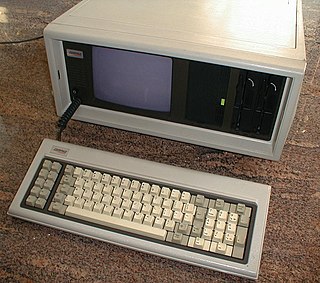 W
WA portable computer is a computer designed to be easily moved from one place to another and included a display and keyboard. The first commercially sold portable was the 50-pound (23 kg) IBM 5100, introduced 1975. The next major portables were Osborne's 24-pound (11 kg) CP/M-based Osborne 1 (1981) and Compaq's 28-pound (13 kg) 100% IBM PC compatible Compaq Portable (1983). These "luggable" computers lacked the next technological development, not requiring an external power source; that feature was introduced by the laptop. Laptops were followed by lighter models, so that in the 2000s mobile devices and by 2007 smartphones made the term almost meaningless. The 2010s introduced wearable computers such as smartwatches.
 W
WThe AlphaSmart was a brand of portable, battery powered, word-processing keyboards manufactured by NEO Direct, Inc.. Originally released in 1993, the first AlphaSmart models were intended for writing on-the-go and could be plugged into a computer to transfer saved written text. The units' portability and long battery life made them valuable to journalists, writers, and students. Later models expanded functionality by spell-checking, running applications, and accessing wireless printers.
 W
WThe Amstrad NC100 Notepad was an A4-size, portable Z80-based computer, released by Amstrad in 1992. It featured 64 KB of RAM, the Protext word processor, various organiser-like facilities, a simple calculator, and a version of the BBC BASIC interpreter.
 W
WThe Apricot Portable was a computing device manufactured by ACT Ltd., and was released to the public in November 1984. It was ACT's first attempt at manufacturing a portable computer, which were gaining popularity at the time. Compared to other portable computers of its time like the Compaq Portable and the Commodore SX-64, the Apricot Portable was the first computer to have an 80-column and 25-line LCD screen and an input/output speech recognition system.
 W
WThe Atari Portfolio is an IBM PC-compatible palmtop PC, released by Atari Corporation in June 1989. This makes it the world's first palmtop computer.
 W
WThe Atari Portfolio is an IBM PC-compatible palmtop PC, released by Atari Corporation in June 1989. This makes it the world's first palmtop computer.
 W
WThe STacy was a portable version of the Atari ST.
 W
WThe Scrib was an early portable computer made by the Swiss company Bobst Graphics, with support from Jean-Daniel Nicoud.
 W
WBondwell was a US and Hong Kong manufacturer of personal computers during the 1980s (1981-1993).
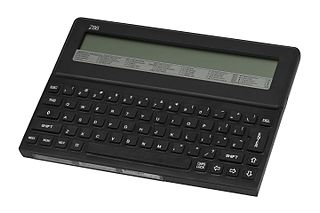 W
WThe Cambridge Computer Z88 is an A4-size, lightweight, portable Z80-based computer with a built-in combined word processing/spreadsheet/database application called PipeDream, along with several other applications and utilities, such as a Z80-version of the BBC BASIC programming language.
 W
WThe Commodore SX-64, also known as the Executive 64, or VIP-64 in Europe, is a portable, briefcase/suitcase-size "luggable" version of the popular Commodore 64 home computer and the first full-color portable computer.
 W
WThe Compaq Concerto was a laptop computer made by Compaq, introduced in 1993. Concerto was the first tablet computer manufactured by Compaq on a large scale, and can be considered a very early form of a 2-in-1 PC.
 W
WCompaq LTE was a line of laptop computers made by Compaq, introduced in 1989. The first models, Compaq LTE and Compaq LTE 286, were among the first computers to be close to the size of a paper notebook, spurring the use of the term "notebook" to describe a smaller laptop, and earned a notable place in laptop history. They were also among the first to include both a built-in hard disk and a floppy disk drive, and later models offered optional docking stations, providing performance comparable to then-current desktop machines.
 W
WThe Compaq Portable is an early portable computer which was one of the first 100% IBM PC compatible systems. It was Compaq Computer Corporation's first product, to be followed by others in the Compaq portable series and later Compaq Deskpro series.
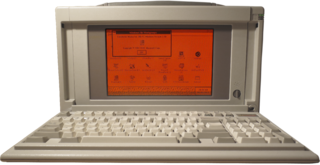 W
WThe Compaq Portable 386 was a computer released by Compaq Computer Corporation in 1987. Its street price upon its release was US$12,000–14,000 for a model equipped with an 20 MHz Intel 80386 CPU, 2 MB RAM, 16 kB ROM, 1.2 MB 5¼-inch floppy, 40 or 100 MB hard disk, priced at US$7,999 or US$9,999 respectively, and a 10" amber colored gas-plasma display.
 W
WThe Compaq Portable 486 is a computer released by Compaq Computer Corporation in 1992. It was the last "luggable" or portable computer released under the Compaq Portable series of computers.
 W
WThe Compaq Portable II was the third product in the Compaq portable series to be brought out by Compaq Computer Corporation. Released in 1986 at a price of US$3499, the Portable II was much improved upon its predecessors. It included an 8 MHz processor, and was lighter and smaller than the Compaq Portable. There were four models of the Compaq Portable II. The basic Model 1 shipped one 5.25" floppy drive and 256kB of RAM. The Model 2 added a second 5.25" floppy drive and sold for $3599. The Model 3 shipped with a 10MB hard disk in addition to one 5.25" floppy drive and 640kB of RAM for $4799 at launch. The Model 4 would upgrade the Model 3 with a 20MB hard drive and sold for $4999. There also may have been a 4.1 MB hard drive included at one point. The Compaq Portable II was significantly lighter than its predecessors, the Model 1 weighed just 23.6 pounds compared to the 30.5 pounds the Compaq Portable 286 weighed. Compaq only shipped the system with a small demo disk, MS-DOS 3.1 had to be purchased separately.
 W
WThe Compaq Portable III is a PC/AT-compatible computer released by Compaq Computer Corporation in 1987. It was advertised as being much smaller and lighter than the previous portable x86-PCs, however it was still quite large by today's standards. Three models were announced at release. The Model 1 had a list price of 3999 USD and was equipped with a 12 MHz Intel 80286, 640 KB RAM, 1.2 MB 5.25" floppy, and a 10" amber colored gas-plasma display. Other options included the Model 20 at 4999 USD which added a 20 MB hard disk, or 5799 USD for the Model 40 with the upgraded 40 MB hard disk. There was also an optional ISA Expansion chassis allowed for 2 full length 16-bit ISA add-in cards for 199 USD. Power is supplied using a mains electricity outlet, no battery exists.
 W
WCompaq's first computers were portable 'lunchbox' or 'luggable' computers, and as such belong to the Compaq Portable series. These computers measured approximately 1×1 foot on the side, and were approx. 2½ ft wide. As the products evolved, laptops and notebooks were created offing a new level of portability that caused the market to explode.
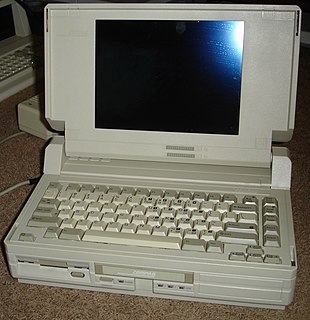 W
WCompaq SLT was a line of laptop computers made by Compaq. The SLT series was the successor to the Portable III and the predecessor to the more well known Compaq LTE. Two models were produced in the SLT series. The first model, named SLT/286, is considered to be one of the most notable units in laptop history due to its battery life and superior performance compared to competing models. It is also notable for being Compaq’s first laptop computer. The SLT/286 had a 12 MHz Harris or Intel 80C286 processor and a grayscale VGA LCD screen, the very first laptop with this feature. The price started at $5,399 for the base-model.
 W
WThe Data General-One (DG-1) was a portable personal computer introduced in 1984 by minicomputer company Data General.
 W
WA desktop replacement computer (DTR) is a personal computer that provides the full capabilities of a desktop computer while remaining mobile. They are often larger, bulkier laptops or in some cases 2-in-1 PCs with a tablet-like form factor and interface. Because of their increased size, this class of computer usually includes more powerful components and a larger display than generally used in smaller portable computers and can have a relatively limited battery capacity. Some use a limited range of desktop components to provide better performance at the expense of battery life. These are sometimes called desknotes, a blend of "desktop" and "notebook", though the term is also applied to desktop replacement computers in general.
 W
WThe Dulmont Magnum was an early laptop computer designed initially by Australian power line equipment manufacturer Dulmison Pty Ltd and subsequently marketed by Dulmont Pty Ltd. Exhibited in September 1983, it was the world's first true battery-powered laptop computer.
 W
WThe Epson PX-4 is a portable CP/M based computer introduced in 1985. The screen was 40×8 characters physical, but 80×25 or 40×50 virtual, making it almost compatible with the Epson PX-8 Geneva. It could be operated from a Nickel-Cadium battery pack, 4xAA batteries, or a 6V 600mA DC power supply.
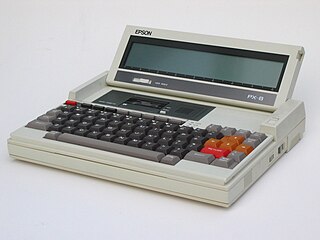 W
WThe Epson PX-8 a.k.a. Geneva was a small laptop computer made by the Epson Corporation in the mid-1980s.
 W
WThe Grundy NewBrain was a microcomputer sold in the early 1980s by Grundy Business Systems Ltd of Teddington and Cambridge, England.
 W
WThe HP 95LX Palmtop PC, also known as project Jaguar, was Hewlett Packard's first MS-DOS-based pocket computer, or personal digital assistant, introduced in April 1991 in collaboration with Lotus Development Corporation. It can be seen as successor to a series of larger portable PCs like the HP 110 and HP 110 Plus.
 W
WThe HP 200LX Palmtop PC, also known as project Felix, is a personal digital assistant introduced by Hewlett-Packard in August 1994. It was often called a Palmtop PC, and it was notable that it was, with some minor exceptions, a MS-DOS-compatible computer in a palmtop format, complete with a monochrome graphic display, QWERTY keyboard, serial port, and PCMCIA expansion slot.
 W
WThe HP 200LX Palmtop PC, also known as project Felix, is a personal digital assistant introduced by Hewlett-Packard in August 1994. It was often called a Palmtop PC, and it was notable that it was, with some minor exceptions, a MS-DOS-compatible computer in a palmtop format, complete with a monochrome graphic display, QWERTY keyboard, serial port, and PCMCIA expansion slot.
 W
WThe HP 200LX Palmtop PC, also known as project Felix, is a personal digital assistant introduced by Hewlett-Packard in August 1994. It was often called a Palmtop PC, and it was notable that it was, with some minor exceptions, a MS-DOS-compatible computer in a palmtop format, complete with a monochrome graphic display, QWERTY keyboard, serial port, and PCMCIA expansion slot.
 W
WThe HP 200LX Palmtop PC, also known as project Felix, is a personal digital assistant introduced by Hewlett-Packard in August 1994. It was often called a Palmtop PC, and it was notable that it was, with some minor exceptions, a MS-DOS-compatible computer in a palmtop format, complete with a monochrome graphic display, QWERTY keyboard, serial port, and PCMCIA expansion slot.
 W
WThe HP 200LX Palmtop PC, also known as project Felix, is a personal digital assistant introduced by Hewlett-Packard in August 1994. It was often called a Palmtop PC, and it was notable that it was, with some minor exceptions, a MS-DOS-compatible computer in a palmtop format, complete with a monochrome graphic display, QWERTY keyboard, serial port, and PCMCIA expansion slot.
 W
WThe HP 200LX Palmtop PC, also known as project Felix, is a personal digital assistant introduced by Hewlett-Packard in August 1994. It was often called a Palmtop PC, and it was notable that it was, with some minor exceptions, a MS-DOS-compatible computer in a palmtop format, complete with a monochrome graphic display, QWERTY keyboard, serial port, and PCMCIA expansion slot.
 W
WThe HP 200LX Palmtop PC, also known as project Felix, is a personal digital assistant introduced by Hewlett-Packard in August 1994. It was often called a Palmtop PC, and it was notable that it was, with some minor exceptions, a MS-DOS-compatible computer in a palmtop format, complete with a monochrome graphic display, QWERTY keyboard, serial port, and PCMCIA expansion slot.
 W
WThe DVW Husky is a handheld British rugged computer issued in 1981 by DVW Electronics.
 W
WThe Hyperion is an early portable computer that vied with the Compaq Portable to be the first portable IBM PC compatible. It was marketed by Infotech Cie of Ottawa, a subsidiary of Bytec Management Corp., who acquired the designer and manufacturer Dynalogic in January 1983. In 1984 the design was licensed by Commodore International in a move that was forecast as a "radical shift of position" and a signal that Commodore would soon dominate the PC compatible market. Despite computers being "hand-assembled from kits" provided by Bytec and displayed alongside the Commodore 900 at a German trade show as their forthcoming first portable computer, it was never sold by Commodore and some analysts downplayed the pact. The Hyperion was shipped in January 1983 at C$4995, two months ahead of the Compaq Portable.
 W
WThe IBM 5100 Portable Computer is a portable computer introduced in September 1975, six years before the IBM Personal Computer. It was the evolution of a prototype called the SCAMP that was developed at the IBM Palo Alto Scientific Center in 1973. In January 1978, IBM announced the IBM 5110, its larger cousin, and in February 1980 IBM announced the IBM 5120. The 5100 was withdrawn in March 1982.
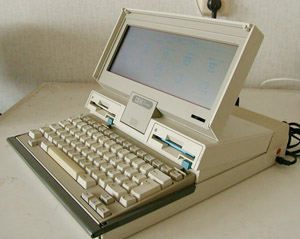 W
WThe IBM PC Convertible is a laptop computer made by IBM, first sold in April 1986. The Convertible was IBM's first laptop-style computer, following the luggable IBM Portable, and introduced the 3½-inch floppy disk format to the IBM product line. Like modern laptops, it featured power management and the ability to run from batteries.
 W
WThe IBM Portable Personal Computer 5155 model 68 is an early portable computer developed by IBM after the success of the suitcase-size Compaq Portable. It was released in February, 1984, and was quickly replaced by the IBM Convertible, only roughly two years after its debut.
 W
WLPA512 was an industrial programmable logic controller—a small, portable computer developed by the Ivo Lola Ribar Institute of Serbia in 1986 as an enhancement to its prior product, PA512. It was first deployed in the Maribor car factory.
 W
WMacintosh Portable is a portable computer designed, manufactured, and sold by Apple Computer, Inc. from September 1989 to October 1991. It is the first battery-powered Macintosh, which garnered significant excitement from critics, but sales to customers were quite low. It featured a fast, sharp, and expensive black-and-white active matrix LCD screen in a hinged design that covered the keyboard when the machine was not in use. The Portable was one of the early consumer laptops to employ an active matrix panel, and only the most expensive of the initial PowerBook line, the PowerBook 170, used one, due to the high cost. The machine was designed to deliver high performance, at the cost of increased price and weight. The Portable was discontinued in October 1991.
 W
WThe Osborne 1 is the first commercially successful portable microcomputer, released on April 3, 1981 by Osborne Computer Corporation. It weighs 10.7 kg (24.5 lb), cost US$1,795, and runs the CP/M 2.2 operating system. It is powered from a wall socket, as it has no on-board battery, but it is still classed as a portable device since it can be hand-carried when packed.
 W
WThe Osborne Executive was the planned successor of the already commercially successful Osborne 1 portable computer by Osborne Computer Corporation. The Executive was a collection of the good features from the Osborne 1 and fixed some of its predecessor's flaws.
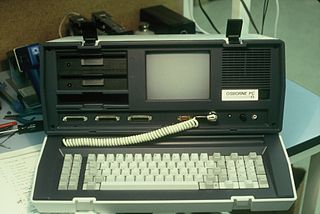 W
WIn the early summer of 1983 an effort was launched to produce a version of the Osborne Executive that would be compatible with the IBM PC. Although venture partners had contributed $9 million of funding in April and another $11 million in June, Osborne was unable to raise an additional $20 million considered necessary to get the IBM-compatible product to market. A "tiger team" was formed, primarily to create a prototype DOS compatible printed circuit board and front bezel to accommodate the changes in connectors. The design used many of the parts of the Executive, including the disc drives, display, chassis, power supply and keyboard. It was completed in six weeks and shown to a number of potential investors, but was unable to generate sufficient interest to save the company from bankruptcy.
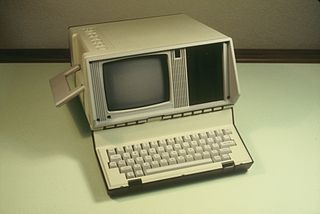 W
WThe Osborne Vixen was a "luggable" portable computer announced by the Osborne Computer Corporation in November 1984, as a follow up to their Osborne 1 and Osborne Executive system.
 W
WThe Outbound laptop is an Apple Macintosh-compatible laptop computer. It is powered by a 15-MHz Motorola 68000 processor. Later versions increased the clock speed to 20 MHz.
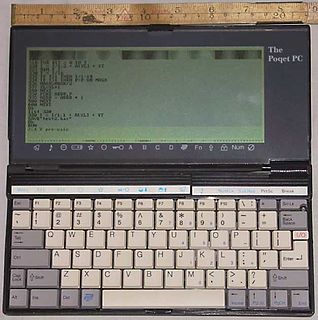 W
WThe Poqet PC is a very small, portable IBM PC compatible computer, introduced in 1989 by Poqet Computer Corporation with a price of $2000. The computer was discontinued after Fujitsu Ltd. bought Poqet Computer Corp. It was the first subnotebook form factor IBM PC compatible computer that ran MS-DOS. The Poqet PC is powered by two AA-size batteries. Through the use of aggressive power management, which includes stopping the CPU between keystrokes, the batteries are able to power the computer for anywhere between a couple of weeks and a couple of months, depending on usage. The computer also uses an "instant on" feature, such that after powering it down, it can be used again immediately without having to go through a full booting sequence. The Poqet PC is comparable to the HP 95LX/HP 100LX/HP 200LX and the Atari Portfolio handheld computers.
 W
WThe Poqet PC is a very small, portable IBM PC compatible computer, introduced in 1989 by Poqet Computer Corporation with a price of $2000. The computer was discontinued after Fujitsu Ltd. bought Poqet Computer Corp. It was the first subnotebook form factor IBM PC compatible computer that ran MS-DOS. The Poqet PC is powered by two AA-size batteries. Through the use of aggressive power management, which includes stopping the CPU between keystrokes, the batteries are able to power the computer for anywhere between a couple of weeks and a couple of months, depending on usage. The computer also uses an "instant on" feature, such that after powering it down, it can be used again immediately without having to go through a full booting sequence. The Poqet PC is comparable to the HP 95LX/HP 100LX/HP 200LX and the Atari Portfolio handheld computers.
 W
WThe Poqet PC is a very small, portable IBM PC compatible computer, introduced in 1989 by Poqet Computer Corporation with a price of $2000. The computer was discontinued after Fujitsu Ltd. bought Poqet Computer Corp. It was the first subnotebook form factor IBM PC compatible computer that ran MS-DOS. The Poqet PC is powered by two AA-size batteries. Through the use of aggressive power management, which includes stopping the CPU between keystrokes, the batteries are able to power the computer for anywhere between a couple of weeks and a couple of months, depending on usage. The computer also uses an "instant on" feature, such that after powering it down, it can be used again immediately without having to go through a full booting sequence. The Poqet PC is comparable to the HP 95LX/HP 100LX/HP 200LX and the Atari Portfolio handheld computers.
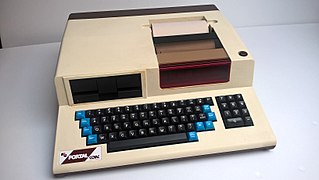 W
WPortal R2E CCMC was a portable microcomputer designed and marketed by the studies and developments department of the French firm R2E Micral and officially appeared in September 1980 at the Sicob show in Paris. The Osborne 1 was released eight months later, in April 1981. specializing in payroll and accounting.
 W
WThe SIMpad is a portable computer developed by the company Keith & Koep by order of Siemens AG, with an 8.4" TFT touchscreen. Commonly used with wireless network cards, it was marketed as a device to browse the World Wide Web. Initially announced in January 2001 at the Consumer Electronics Show, the SIMpad was not very popular in the mainstream US market.
 W
WA smartphone is a mobile device that combines cellular and mobile computing functions into one unit. They are distinguished from feature phones by their stronger hardware capabilities and extensive mobile operating systems, which facilitate wider software, internet, and multimedia functionality, alongside core phone functions such as voice calls and text messaging. Smartphones typically contain a number of metal–oxide–semiconductor (MOS) integrated circuit (IC) chips, include various sensors that can be leveraged by their software, and support wireless communications protocols.
 W
WThe ST BOOK is a portable computer released in 1991 by Atari. It was based on the Atari STE. The ST BOOK was vastly more portable than the previous Atari portable, the STacy, but it sacrificed several features in order to achieve this: notably the backlight, and internal floppy disc drive.
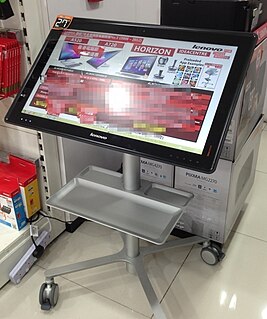 W
WA table computer, or a table PC, or a tabletop is a device class of a full-featured large-display portable all-in-one computer with an internal battery. It can either be used on a table's top, hence the name, or carried around the house.
 W
WThe Texas Instruments Compact Computer 40 or CC-40 is a battery-operated portable computer that was developed by Texas Instruments and released in March 1983. Priced at US$249, it weighs 600 grams and can be powered by four AA batteries or an AC adapter. It was intended as a portable business computer, and uses TI's TMS70C20 CPU, an 8-bit microprocessor that runs at 2.5 MHz.
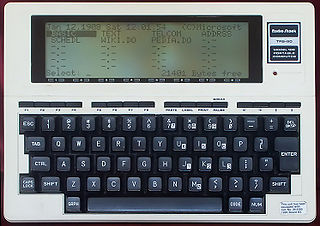 W
WThe TRS-80 Model 100 is a portable computer introduced in 1983. It is one of the first notebook-style computers, featuring a keyboard and liquid crystal display, in a battery-powered package roughly the size and shape of a notepad or large book.
 W
WThe Zorba was a portable computer running the CP/M operating system manufactured in 1983 and 1984. It was originally manufactured by Telcon Industries of Fort Lauderdale, Florida, a company specialized in telecommunication equipment manufacturing.
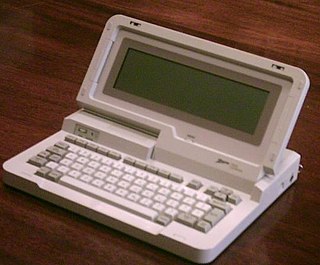 W
WThe ZP-150 was one of the early commercially available portable computers. It was released in late 1984 by Zenith data systems and sold by Heathkit.